Considering History: The Presidency and Impeachment of Andrew Johnson
This column by American studies professor Ben Railton explores the connections between America’s past and present.
One hundred fifty years ago, Andrew Johnson became the first president of the United States to be impeached.
In 1864, facing a stiff challenge to his reelection campaign from Democratic nominee (and former Union general) George McClellan, President Abraham Lincoln decided to replace his current vice president, Hannibal Hamlin, on the ticket with a Democrat, Tennessee Senator and military governor Andrew Johnson. This choice allowed Lincoln and Johnson to run under the banner of the newly created National Union Party, emphasizing opposition to the Confederacy across the nation (and especially in contested border states like Tennessee). It was a pragmatic and clever strategic move, and likely contributed greatly to Lincoln’s eventual easy victory over McClellan in November 1864.
Yet as early as inauguration day, March 4, 1865, there were indications that Lincoln’s practical decision might have also been a mistake. Johnson may have been drunk at the inauguration (he had been witnessed drinking heavily at a party the night before and asked Hannibal Hamlin for two additional drinks just before the inauguration began), and in any case delivered a rambling, belligerent speech that was hastily cut off when Hamlin swore him in as the new vice president. And this ominous opening foreshadowed what would become, after Lincoln’s tragic April 14th assassination, one of the most divisive and destructive presidencies in American history.
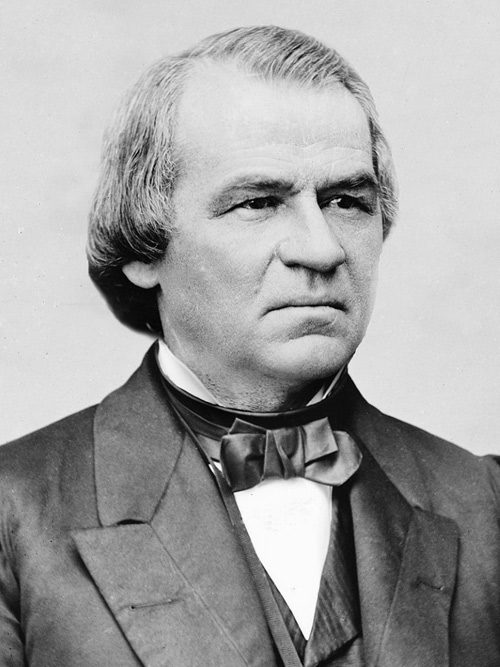
Johnson continued his pattern of belligerent and bellicose public statements as President. When supporters came to the White House in February 1866 for a Washington’s Birthday celebration, Johnson addressed them in another long, rambling speech, highlighting his own accomplishments more than 200 times and attacking “men still opposed to the Union” who were “as much laboring to pervert or destroy [fundamental American principles] as were the men who fought against us.” When pressed by audience members, he named Congressman Thaddeus Stevens and Senator Charles Sumner (among others) as these enemies. In August and September of that year he would embark on a national speaking tour unprecedented for a sitting president; known as the “Swing Around the Circle,” the tour featured more than twenty rallies in which Johnson continued to attack Congressional “enemies” and make the case for his divisive Presidential Reconstruction policies ahead of the November midterm elections.
Those extreme Presidential Reconstruction policies truly defined Johnson’s divisive and disastrous administration, both on their own terms and in contrast to what might have been the case had Lincoln not been killed. Although Johnson had been perceived as a moderate on issues of slavery and sectionalism prior to and during the Civil War, as president he revealed himself to be both a staunch ally of the neo-Confederate South and a virulent white supremacist. Among his earliest presidential proclamations, Johnson first recognized a provisional Virginia government that was practicing policies of forgiveness toward ex-Confederates and then provided federal amnesty for nearly all ex-rebels. He went on to support additional amnesty policies such as one that allowed ex-Confederates (such as former vice president of the Confederacy Alexander Stephens) to serve in Congress; since Johnson’s administration likewise opposed proposals for African American voting rights, nearly all of the Southerners elected to Congress in these early post-war years were former Confederates.
Johnson’s opposition to post-war rights for African Americans went far beyond opposing suffrage proposals. In February 1866 he vetoed a bill that would have extended the vital operations of the Freedmen’s Bureau beyond the agency’s scheduled 1867 abolition, claiming that the law “would not be consistent with the public welfare.” In March of the same year he vetoed the groundbreaking Civil Rights Bill, arguing in his veto message that “the distinction of race and color is by the bill made to operate in favor of the colored against the white race.” Johnson also opposed the 14th Amendment and campaigned extensively (if unsuccessfully) against its ratification by the states, solidifying his administration’s overall hostility to nearly all Reconstruction measures that focused on civil rights rather than reintegrating the Confederate South into the nation as smoothly as possible.
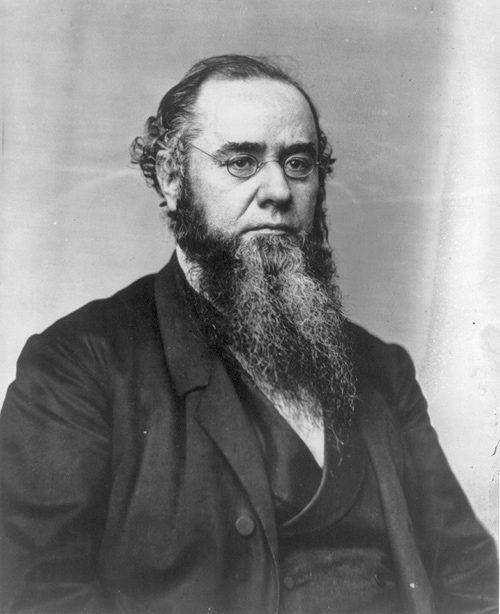
All those conflicts contributed to Johnson’s February 1868 impeachment by the House of Representatives, but it was his blatant, authoritarian violation of a specific law that directly precipitated the Congressional action. During his 1866 speaking tour, Johnson had pledged to fire Cabinet secretaries who did not agree with him (especially those who had been appointed under Lincoln), and in March 1867 he vetoed the Tenure of Office Act, which required Senate approval for such firings; Congress overrode his veto and passed the act into law. Throughout that year Johnson battled with Secretary of War Edwin Stanton, a Lincoln appointee and advocate of Congressional Reconstruction, harsher treatment of former Confederates, and African American rights. In August, with Congress out of session and unable to approve any Cabinet actions, Johnson demanded Stanton’s resignation; when Stanton refused, Johnson suspended him and replaced him with General of the Army Ulysses S. Grant. The conflict continued for many months, and when Johnson permanently dismissed Stanton in February 1868 without gaining Senate approval as required by law, the House of Representatives voted 128 to 47 to impeach.
After a three-month trial in the Senate, featuring so much wheeling and dealing that Johnson and his allies would later be investigated by Representative Benjamin Butler for bribery, the Senate on May 16, 1868, fell a single vote short of the two-thirds majority necessary to convict the president. Johnson would complete the remainder of his term, but as a deeply unpopular president; even his own Democratic Party denied him the 1868 presidential nomination in favor of former New York Governor Horatio Seymour (who would lose to the Republican nominee Ulysses S. Grant). On Christmas Day, 1868, Johnson took advantage of one of his last opportunities to further his neo-Confederate and white supremacist agendas, issuing a blanket amnesty that covered all former Confederates including the Confederate President Jefferson Davis.
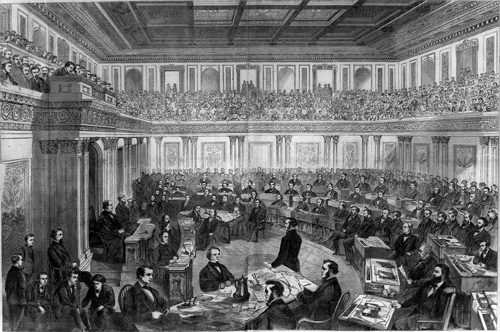
Johnson’s political career did not quite end with Grant’s election, as he made a successful run for a Tennessee Senate seat (at that time still decided by the state legislature) in early 1875. He would only serve for a few months before dying unexpectedly of a stroke in July, but during that time expressed his neo-Confederate views one last time (his only official remarks during his brief Senate term), criticizing Grant’s use of federal troops in Louisiana and asking, “How far off is military despotism?” One final belligerent and extreme remark from a president who remains one of the most divisive and destructive in American history.
The Impeachment of Andrew Johnson: A Timeline
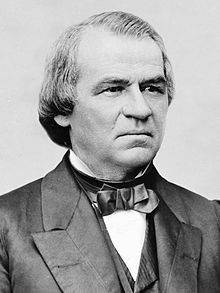
Considering how often it is demanded by political opponents in recent years, impeachment of the president has rarely been used, and it’s never resulted in a president’s removal from office. Only two presidents have been impeached: Andrew Johnson and Bill Clinton. Many are familiar with the events surrounding the Clinton spectacle, but fewer know what led to President Johnson’s impeachment in the tumultuous months after Lincoln’s assassination and the end of the Civil War.
Andrew Johnson’s impeachment and trial shows how difficult indicting a president can be — even when it has the support of the Senate’s majority. This timeline walks you through the contentious details from 150 years ago. (For more on how impeachment works, read our “Quick Guide to Impeachment.”)
April 15, 1865
In the hours following the death of President Lincoln, Vice President Andrew Johnson, a Democrat, is sworn into office. When the Civil War had started, he’d been the governor of Tennessee and a valuable union supporter in a border state. In 1864, after he was elected vice president, he repeatedly promised to hang all the leaders of the Confederacy when the war was over. Now, as president, and with the southern leaders powerless, he would have that chance.
But Lincoln died before detailing how he planned to reunify the country. Johnson only knows Lincoln wanted to extend clemency and bring the seceded states back into the union as quickly as possible.
May 29, 1865
Johnson offers amnesty to all ex-rebels who hold property valued at less than $20,000, which excludes propertied men of the South who had been leaders of the secession. However, many of these leaders come to Washington to ask for clemency, which Johnson usually gives.
1865-1866
Johnson faces a growing opposition in Congress from legislators who are concerned that the former Confederate states are rebuilding their old status quo, electing their old leaders, and denying civil rights to emancipated slaves. They learn that Southern states are passing laws against vagrancy. These “Black Codes” require many African-Americans to sign year-long work contracts or face the risk of fine or imprisonment, in effect forcing them back onto plantations.
Not wanting to lose what the North had fought for, these legislators, who are now termed Republican Radicals, mount increasing opposition to Johnson.
1866
Bypassing Congress, Johnson tours northern states to build public support for his lenient plans for reconstruction, but fails to win followers in any appreciable numbers.
During his tour, President Johnson promises to eject members of the Cabinet he has inherited from Lincoln who are now opposing his policies toward the South. He says Edwin Stanton, secretary of war and one of the leading radicals, is one of the first he will dismiss.
January 1867
Congressman Thaddeus Stevens is strongly opposed to Johnson’s conciliatory approach to the South. To prevent the Old South from returning to power, Stevens introduces a new Reconstruction Act. It would dismantle the Southern state governments and establish five military districts with military governors. They would govern the states until new constitutions that ensure suffrage for all voters are written.
March 2, 1867
Congress, led by Stevens, responds to Johnson’s threat to dismiss Stanton by passing the Tenure of Office Act. It would prohibit the president from removing any government official who’d been approved by the Senate without first obtaining the Senate’s permission.
Johnson vetoes the act. The following day, Congress overrides a presidential veto for the first time to make the Tenure of Office Act law.
February 21, 1868
Believing the Tenure of Office Act to be unconstitutional, Johnson tells Congress he is unilaterally ordering Stanton to leave the office of secretary of war.
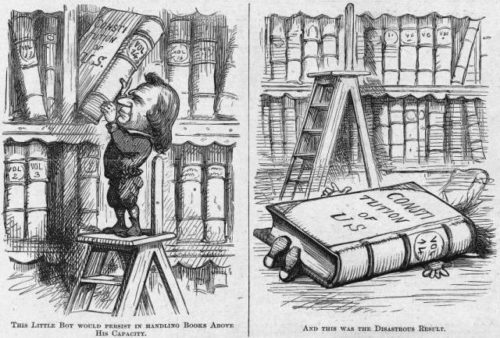
February 24, 1868
Stevens demands that Johnson be impeached. The House of Representatives votes to impeach Johnson, with 128 Republicans voting for the measure and 47 Democrats opposing it.
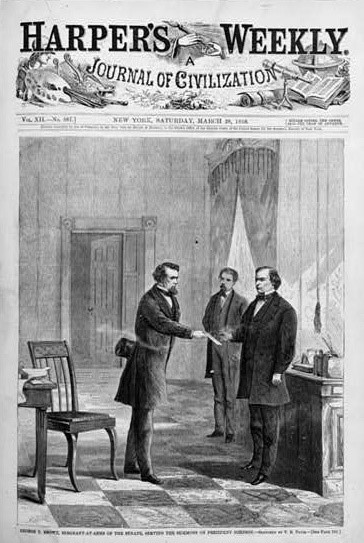
February 29, 1868
Eleven articles of impeachment are agreed upon. Most are based on Johnson’s action of dismissing Stanton.
March 30, 1868
The trial in the Senate begins.
May 16, 1868
The Senate votes on one of the 11 articles of impeachment. It has been chosen for the first vote because it has the greatest support in the Senate. The vote, 35 to 19, falls one vote short of the two-thirds majority needed for conviction.
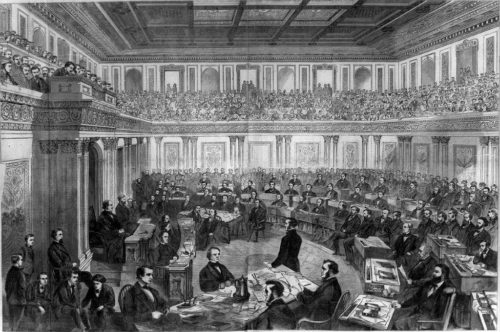
May 26, 1868
The Republicans aren’t prepared for defeat. They come back on this day to vote on other articles of impeachment, but again fail to gain a two-thirds majority. Johnson remains president.
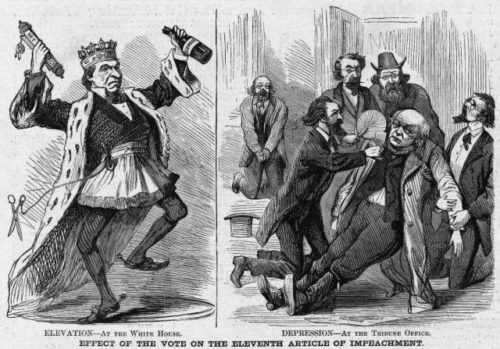
Aftermath
Stanton leaves his position as secretary of war. Johnson finishes his term the following year and returns to Tennessee. In 1875, he becomes the only former president to be elected to the senate, but dies a few months later.
The vote that prevented conviction of Johnson, a Democrat, was cast by a Republican who voted against his party’s leaders. He was Kansas senator Edmund Ross. He said he changed his mind at the last minute and voted “not guilty” because, upon reflection, he voted from his conscience. He believed the charges didn’t warrant conviction. Yet his motives might not have been entirely driven by his principles. The next month, he asked President Johnson for, and received, six political appointments for his friends, reminding Johnson of the supporting vote he cast in the impeachment trial.
Featured image: Harper’s Weekly, May 30, 1868